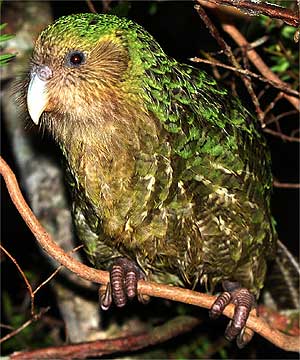3 Facts about Kakapo
1. The Kakapo is not only the rarest parrot on earth, but also the
most extraordinary.
2. This, a little fat bird, never, no, absolutely not, try to use
its wings to fly.
3. This parrot is also known as the bird with the longest lifetime
in the world.
The Kakapo (Maori: kakapo, meaning night
parrot), Strigops habroptila, also called owl parrot,
is a species of large, flightless nocturnal parrot endemic to
New Zealand
The Kakapo was originally described by English ornithologist
George Robert Gray in 1845. Its generic name is derived
from the Ancient Greek strix, genitive strigos "owl",
and ops "face", while its specific epithet comes from
habros "soft",
and ptilon "feather". It has so many unusual features
that it was initially placed in its own tribe, Strigopini.
It has finely blotched yellow-green plumage, a distinct facial
disc of sensory, vibrissa-like feathers, a large grey beak,
short legs, large feet, and wings and a tail of relatively short
length. |
 Kakapo,
Strigops habroptila - Overblikk
Kakapo,
Strigops habroptila - Overblikk
BBC Natural History Unit
www.arkive.org
|
A certain combination of traits makes it unique among its
kind—it is the world's only flightless parrot, the heaviest
parrot,
nocturnal and herbivorous.
The Kakapo is critically endangered; as of February 2012, only
126 living individuals are known,
most of which have been given names.
Because of Polynesian and European colonisation and the introduction
of predators such as cats, rats, ferrets, and stoats,
the Kakapo was almost wiped out. Conservation efforts began
in the 1890s, but they were not very successful until the
implementation of the Kakapo Recovery Plan in the 1980s. As
of January 2009, surviving Kakapo are kept on two
predator-free islands, Codfish (Whenua Hou) and Anchor islands,
where they are closely monitored.
Two large Fiordland islands,
Resolution and Secretary, have been the subject of large-scale
ecological restoration activities to prepare self-sustaining
ecosystems with suitable habitat for the Kakapo. |
Fiordland
Nasjonal Park ligger i det sydvestlige hjørne av South Island
in New Zealand.
Den er den største av 14 nasjonal parker som i øyeblikket
eksisterer på New Zealand med et område på 12,500
km ².
Fiordland kysten er kupert, med fjorder som sprer seg gjennom dalene
i syd-Alpene (!) og slike fjellområder som Kepler Murchison.
I den nordlige delen av parken er det flere fjelltopper som rager
over 2,000 m.
©
http://www.newzealandholidays.org.uk
|
The Kakapo, like many other New Zealand bird species, was
historically important to the Maori, the indigenous people
of New Zealand, appearing in many of their traditional legends
and folklore. It was hunted and used as a resource by
Maori, both for its meat as a food source and for its feathers,
which were used to make highly valued pieces of clothing.
It was also sometimes kept as a pet.
The Kakapo is a large, rotund parrot; the male measures up
to 60 cm and weighs from 2 to 4 kg at maturity.
The Kakapo cannot fly, having short wings for its size and
lacking the pronounced keel bone (sternum) that anchors the
flight muscles of other birds. It uses its wings for balance,
support, and to break its fall when leaping from trees.
Unlike other land birds, the Kakapo can accumulate large amounts
of body fat to store energy, making it the heaviest
parrot.
The Kakapo has a well-developed sense of smell, which complements
its nocturnal lifestyle. It can discriminate among
odours while foraging; a behaviour reported for only one other
parrot species
|
Though the Kakapo cannot fly, it is an excellent climber,
ascending to the crowns of the tallest trees. It can also "parachute"
- descending by leaping and spreading its wings. In this way
it may travel a few metres at an angle of less than 45 degrees.
Males loosely gather in an arena and compete with each other
to attract females. Females listen to the males as they
display, or "lek". They choose a mate based on the
quality of his display; they are not pursued by the males in
any overt way.
No pair bond is formed; males and females meet only to mate.
|
 podocarp-hardwood-forest
http://www.doc.govt.nz/conservation/native-plants/podocarp-hardwood-forests/
podocarp-hardwood-forest
http://www.doc.govt.nz/conservation/native-plants/podocarp-hardwood-forests/
|
The female Kakapo lays up to three eggs per breeding
cycle. She nests on the ground under the cover of plants or
in
cavities such as hollow tree trunks. The female incubates the
eggs faithfully, but is forced to leave them every night in
search of food. Predators are known to eat the eggs and the
embryos inside can also die of cold in the mother's absence.
Kakapo eggs usually hatch within 30 days, bearing fluffy gray
chicks that are quite helpless. After the eggs hatch,
the female feeds the chicks for three months, and the chicks
continue to remain with the female for some months after
fledging. The young chicks are just as vulnerable to predators
as the eggs, and young have been killed by many of the
same predators that attack adults. Chicks leave the nest at
approximately 10 to 12 weeks of age. As they gain greater
independence, their mothers may feed the chicks sporadically
for up to 6 months.
Because the Kakapo is long-lived, with an average life expectancy
of 95 years and the maximum at about 120 years,
it tends to have an adolescence before it starts breeding. Males
do not start to boom until about 5 years of age.
Generally females do not seek out males until they are between
9 and 11-years-old. The Kakapo does not breed every
year and has one of the lowest rates of reproduction among birds.
Breeding occurs only in years when trees mast (fruit
heavily), providing a plentiful food supply. Rimu mast occurs
only every three to five years, so in rimu-dominant forests
such as those on Codfish Island, Kakapo breeding occurs as infrequently. |
Text http://en.wikipedia.org/wiki/Kakapo#cite_note-Hagelin04-23
|











